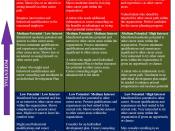Running head: CASE STUDY: EMPLOYEE RETENTION 1 �PAGE � Employee Retention � PAGE �2�
Employee Retention April 10, 2012
�
This is a critique is based on two articles, in which addresses the issues of employee retention and suggestions for the motivation and engagement of employees in the hospitality industry. The first article is titled "Targeted employee retention: Performance-based and job-related differences in reported reasons for staying" by Hausknecht, Rodda, and Howard (2009), in which addresses the major theories to help in explaining the reason that employees stay or leave their organization, and ways to retain them. The second is titled "Terms of engagement" written by David MacLeod (2010) that presents suggest ways for motivating and engaging employees so they will want to stay.
Analysis of Key Points in "Targeted employee retention"
Reasons employees want to stay with their company
According to this article, the primary reason that employees stay with their employer are job satisfaction; they enjoy the work involved in serving customers.
For many employees, the reasons for staying are for the extrinsic rewards such as pay, benefits and advancement opportunities. Employees want to receive fair rewards for their efforts. If these rewards are not presently found, employees may leave for other opportunities that offer greater rewards. Another factor is "constituent attachments, in the form of effective supervision and positive peer group relations," (Hausknecht et tal, 2009, p. 3). Other incentives to retaining employees are organizational commitment and prestige. The secondary reasons are compensation, competitive wages, health benefits, retirement contributions, and incentive plans. Additional reasons for staying are "constituent attachments, organizational commitment, organizational prestige, lack of alternatives, investments, advancement opportunities, location, organizational justice, flexible work arrangements, and non-work influences" (p.10). Companies must find ways to keep their employees satisfied so they will not want to leave.
Retention
Retention is the most important part of a company's approach to talent management. When organizations cannot retain high performers, its core leadership base will eventually erode as a result of losses in performance, high replacement costs, and potential talent shortages. Because of this, employers are seeking "to retain high performers and replace low performers with workers who bring greater skills and abilities to the organization" (p. 5). More important than understanding the reasons why people stay is in understanding how retention factors are different between high performers and others at different levels within the company, (p. 2). The authors suggest that organizations should adopt specific strategies retention of their most valued employees rather than those that are considered average or low performers, (p. 2).
Analysis of Key Points in "Terms of engagement"
Benefits of better engagement
The hospitality industry places certain pressures on its employees such as long hours, in which can interfere with their social life, and oftentimes having seasonal nature make it more difficult to retain good people. Engaged employees are far more likely to stay with the company than those who are disengaged. In such a highly-pressured environment as the hospitality industry, it is more difficult to more effectively assess and engage employees. According to the author, there are steps that employers can follow to help ensure employees are committed to delivering great customer experiences along with delivering longer-term growth and success, (MacLeod, 2010).
Define a clear and compelling goal
Oftentimes employees feel that management does not clearly communicate business objectives to them, in which may give the impression that senior managers do not have a clear vision for the future of the business. That is the reason the author states the importance of communication, and having a clear vision concerning the direction of the company, the goals to achieve, and how the employee fits in to that vision, (MacLeod, 2010). On a personal level, employees want to know what those plans are and how it will affect, (MacLeod, 2010).
Involve employees
One of the important factors to effective engagement is to involve the employees in sharing their insights into how particular issues can be addressed, such as relating to customer service issues, or how the business is promoted. It is also important to provide feedback on the points they do bring up because employees that are involved in sharing their insights tend to be more engaged in the day-to-day operations of the business, (MacLeod, 2010).
Commit to regular communication
Whether the economic climate is strong or weak, it is important that management commit regularly to open communication by sharing information with employees throughout the year concerning the performance of the business along with any issues or challenges that they may have. By having open communications with the employees is the key to an effective employer/ employee relationship, in which builds and maintains trust, (MacLeod, 2010).
Summary and Opinion
Employee turnover in the hospitality industry is an issue that most business owners face. Hospitality businesses can reduce the turnover rate significantly by paying more attention to the needs of their staff because happy employees make happy customers. The analysis of the key points in the first article; by Hausknecht, Rodda, and Howard (2009) is more about how to retain employees rather then that the reasons they quit. A primary concern for many organizations is that of retaining top talent. If organizations fail to retain their employees, it will hinder their ability to remain competitive because of a less qualified workforce. The author's goal for this study was to generate a foundation relating to employees' reported reasons for staying and to review "the major theories that have been advanced in the literature over the past 50 years that help explain why employees stay or quit," (p. 2). After the hospitality industry has faced a serious challenge of retaining employees, MacLeod (2010), in his article "Terms of engagement" presents a research on the management teams of the hospitality industry. The analysis of the key points in this article was that the research presents suggestions for the motivation of employees and for employee engagement, including a clear goal, involvement of employees and analysis of behavior. The author states the importance of communicating this vision so the employees will know how this vision will personally affect them.
As I read these articles, what comes to my mind is the concept of fusion; between retention high performance employees with the motivation of employees and employee engagement. If this cannot be achieved, it will continue to lead to labor turnover, which is very costly. The most important thing to remember in the hospitality industry is that the customer is number one; always. But this cannot be achieved without valuable employees who believe the same thing. Before the customer can be treated as number one, the employees must be first because happy employees lead to happy customers.
�
References
Hausknecht, J. P., Rodda, J., & Howard, M. J. (2009). Targeted employee retention: Performance-based and job-related differences in reported reasons for staying. Human Resource Management, 48(2), 269-288.
MacLeod, D. (2010). Terms of engagement. Caterer & Hotelkeeper, 200(4618), 56-58.


